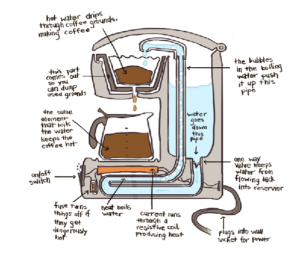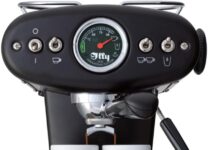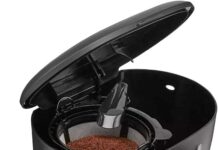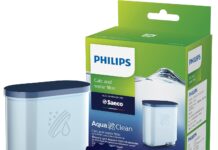We all love a delicious cup of coffee to kickstart our day, but have you ever wondered how those single serve coffee makers work their magic? In this article, we will take a behind-the-scenes look at the inner workings of these compact yet powerful machines that consistently deliver our favorite brews. Whether you are a coffee enthusiast or simply curious about the process, join us as we uncover the fascinating mechanics and technology behind the single serve coffee maker phenomenon. Get ready to dive into the world of aromatic coffee brewing!
This image is property of qph.cf2.quoracdn.net.
Overview
Definition of a Single Serve Coffee Maker
A single serve coffee maker is a convenient and efficient appliance that is designed to brew a single cup of coffee at a time. Unlike traditional coffee makers that brew a pot of coffee, single serve coffee makers are designed for individual use, allowing users to make a fresh cup of coffee quickly and easily.
Advantages of Single Serve Coffee Makers
Single serve coffee makers offer numerous advantages over traditional coffee makers. Firstly, they provide the convenience of brewing a single cup of coffee at any time, eliminating the need to make a full pot of coffee. This is especially beneficial for individuals who live alone or have different coffee preferences within the household. Additionally, single serve coffee makers are more energy-efficient as they only heat the amount of water needed for a single cup, eliminating the energy wasted on heating unused water in traditional coffee makers. They also provide the ability to choose from a wide variety of coffee flavors and blends by using different coffee pods or capsules, catering to individual taste preferences. Lastly, single serve coffee makers are easy to clean and maintain, requiring less effort and time compared to traditional coffee makers.
Types of Single Serve Coffee Makers
There are various types of single serve coffee makers available on the market. The most common types include pod-based coffee makers, which utilize pre-packaged coffee pods or capsules, and espresso machines that use coffee ground or coffee beans to make espresso shots. Each type of single serve coffee maker has its unique features and functionalities, catering to different coffee preferences and brewing methods.
Components of a Single Serve Coffee Maker
A typical single serve coffee maker consists of several key components. These include a water reservoir to hold the water needed for brewing, a heating element to heat the water to the desired temperature, a pump or pressure mechanism to deliver the water to the coffee grounds, a brewing chamber or filter to hold the coffee grounds or coffee pod, and a dispensing mechanism to pour the brewed coffee into a cup. Each component plays a crucial role in the coffee-making process, ensuring that the end result is a delicious and flavorful cup of coffee.
Working Principle
Water Heating and Injection
The first step in the working principle of a single serve coffee maker is water heating and injection. The water reservoir, located at the back or side of the machine, is filled with the desired amount of water. The heating element, often located at the bottom of the coffee maker, heats the water to the optimal brewing temperature, typically between 195 to 205 degrees Fahrenheit. Once the water reaches the desired temperature, it is ready for injection into the brewing chamber.
Coffee Pod Insertion
Before brewing can begin, a coffee pod or capsule must be inserted into the brewing chamber. Coffee pods are pre-packaged with the perfect amount of coffee grounds, ensuring consistency and convenience. There are various types of coffee pods available, from different coffee brands and flavors to accommodate individual taste preferences. Compatible coffee pod systems vary depending on the coffee maker brand and model. However, most single serve coffee makers accept a variety of coffee pod formats, providing users with a wide range of options.
Brewing and Extraction
Once the coffee pod is inserted into the brewing chamber, the brewing process can begin. The coffee maker’s pump or pressure mechanism delivers hot water from the water reservoir into the brewing chamber. The water then passes through the coffee grounds inside the coffee pod, extracting the flavors and aromas from the coffee. The pressure and temperature control within the coffee maker ensure that the coffee is brewed at the optimal conditions for maximum flavor extraction. The brewing process typically takes less than a minute, providing users with a quick and efficient brewing experience.
Coffee Dispensing
Once the brewing process is complete, the brewed coffee is dispensed into a cup or mug. The coffee maker’s dispensing mechanism directs the brewed coffee through a drip tray, which collects any excess liquid or spills. The size of the cup can often be selected on the machine, allowing users to customize their brew to their desired serving size. Some single serve coffee makers also offer the option to adjust the brew strength, enabling users to make their coffee weaker or stronger according to their preference.
This image is property of cdn4.explainthatstuff.com.
Water Heating and Injection
Water Reservoir
The water reservoir is a key component of a single serve coffee maker, responsible for holding the water used in the brewing process. It is often located at the back or side of the machine and has clear markings to indicate the water level. The size of the water reservoir can vary depending on the coffee maker model, with some holding enough water for multiple cups of coffee. A larger water reservoir means fewer refills and more convenience.
Heating Element
The heating element in a single serve coffee maker is responsible for heating the water to the optimal brewing temperature. Most coffee makers use an electric heating element located at the bottom of the machine. When turned on, the heating element heats the water rapidly, bringing it to the desired temperature for brewing. This ensures that the water is hot enough to extract the flavors from the coffee grounds, resulting in a rich and flavorful cup of coffee.
Pump or Pressure Mechanism
The pump or pressure mechanism in a single serve coffee maker is responsible for delivering the water from the water reservoir to the brewing chamber. It operates based on the principle of creating pressure to force the water through the coffee grounds. This pressure ensures that the water comes into contact with the coffee grounds at the right intensity and speed, allowing for optimal flavor extraction. The pump or pressure mechanism is carefully designed to provide consistent and controlled water flow for a delicious cup of coffee every time.
Coffee Pod Insertion
Types of Coffee Pods
Coffee pods are pre-packaged containers that hold a specific amount of coffee grounds. They come in various shapes, sizes, and materials, depending on the brand and coffee maker compatibility. The most commonly used coffee pods are the single-use, sealed pods made of either plastic or aluminum. These pods are designed to keep the coffee fresh and prevent air, light, and moisture from affecting its quality. Other types of coffee pods include refillable pods, which allow users to fill them with their own coffee grounds, and biodegradable pods, which are more environmentally friendly.
Compatible Coffee Pod Systems
Each single serve coffee maker brand and model has its specific compatibility with coffee pod systems. This means that certain coffee pods may work with one machine but not with another. It is essential to check the coffee maker’s user manual or product description to determine the compatible coffee pod systems. Some popular coffee pod systems include Keurig K-Cup, Nespresso, Tassimo T-Discs, and Verismo pods.
Loading and Ejecting Coffee Pods
Loading a coffee pod into a single serve coffee maker is a simple process. The machine usually has a dedicated compartment or slot where the coffee pod is inserted. Depending on the coffee maker design, the compartment may be located on the top, side, or front of the machine. Users need to follow the manufacturer’s instructions to ensure proper pod placement. Ejecting a used coffee pod is equally easy, as most coffee makers have a mechanism that allows for easy pod removal. The used pod can then be disposed of or recycled, depending on the type of pod used.
This image is property of static01.nyt.com.
Brewing and Extraction
Brewing Process
The brewing process in a single serve coffee maker involves the infusion of hot water through the coffee grounds inside the coffee pod. Once the coffee pod is loaded into the brewing chamber, the machine’s pump or pressure mechanism delivers hot water from the water reservoir into the chamber. The water comes into contact with the coffee grounds, extracting the flavors, oils, and aromas from the coffee. The brewing time is typically short, usually less than a minute, ensuring a quick and efficient brewing experience.
Pressure and Temperature Control
To ensure the coffee is brewed to perfection, single serve coffee makers often feature pressure and temperature control mechanisms. The pressure control system regulates the intensity at which the water is forced through the coffee grounds, ensuring optimal extraction. Temperature control ensures that the water is heated to the ideal brewing temperature. These control mechanisms work in tandem to produce a cup of coffee that is rich, flavorful, and brewed to the user’s preference.
Extraction Time
Extraction time refers to the duration during which the water comes into contact with the coffee grounds in the brewing chamber. The extraction time in a single serve coffee maker is typically short, ensuring a quick brewing process. The duration of extraction can vary depending on the coffee maker model and personal preference. Some coffee makers allow users to adjust the extraction time, enabling them to customize the strength and intensity of their coffee.
Filtering Mechanism
During the brewing process, a single serve coffee maker employs a filtering mechanism to separate the extracted coffee from the coffee grounds. The filtering mechanism ensures that the brewed coffee is free from any coffee residues or sediments, resulting in a smooth and clean cup of coffee. The type of filter used can vary depending on the coffee maker model. Some coffee makers use paper filters, while others have built-in metal or mesh filters that can be washed and reused.
Coffee Dispensing
Drip Tray
The drip tray in a single serve coffee maker serves as a platform to collect any excess liquid or spills that may occur during the brewing process or coffee dispensing. It helps keep the brewing area clean and prevents any mess or damage to the countertop or machine. The drip tray can be easily removed and cleaned, ensuring hygienic and hassle-free coffee making.
Cup Size Selection
Many single serve coffee makers offer the option to select the size of the cup for brewing. This feature allows users to customize their coffee to their desired serving size. Whether someone prefers a small, medium, or large cup of coffee, the coffee maker can be adjusted accordingly. This versatility makes single serve coffee makers suitable for individuals with varying coffee consumption preferences.
Brew Strength Customization
In addition to cup size selection, some single serve coffee makers offer the option to customize the brew strength. This feature allows users to adjust the intensity and concentration of the brewed coffee to their liking. Whether someone prefers a milder or stronger cup of coffee, the brew strength customization allows for greater flexibility and ensures that the coffee suits individual taste preferences.
This image is property of dq3atogbtxhm1.cloudfront.net.
Maintenance and Cleaning
Regular Descaling
To maintain optimal performance and longevity, single serve coffee makers require regular descaling. Descaling refers to the removal of mineral deposits, such as calcium and limescale, that can accumulate over time inside the machine’s water reservoir, heating element, and tubing. Descaling solutions or descaling kits specifically designed for single serve coffee makers are available and should be used according to the manufacturer’s instructions. Regular descaling ensures that the machine continues to function smoothly and prevents any potential clogs or issues.
Cleaning the Drip Tray
Cleaning the drip tray is an essential part of maintaining hygiene and cleanliness when using a single serve coffee maker. The drip tray should be regularly removed, emptied, and cleaned to prevent any mold or bacteria growth. Some coffee makers have removable and dishwasher-safe drip trays, making cleaning even more convenient. It is important to follow the manufacturer’s cleaning instructions and guidelines to ensure proper maintenance.
Replacing Filters
Depending on the coffee maker model, it may have filters that need to be replaced regularly. Filters, such as paper or mesh filters, help ensure that the brewed coffee is free from impurities and coffee grounds. Over time, these filters can become clogged or lose their effectiveness, affecting the quality of the coffee. It is important to consult the coffee maker’s user manual to determine the replacement interval for the filters and follow the manufacturer’s recommendations.
Cleaning the Brewing Chamber
The brewing chamber of a single serve coffee maker requires regular cleaning to remove any coffee residue or buildup that may accumulate over time. Cleaning the brewing chamber is typically a straightforward process and involves wiping it down with a damp cloth or rinsing it with warm water. Some coffee makers have removable brewing chambers that can be cleaned separately. Regular cleaning helps prevent any flavor contamination and ensures that each cup of coffee is fresh and delicious.
Common Issues and Troubleshooting
Machine Not Powering On
If a single serve coffee maker does not power on, the first step is to ensure that it is properly plugged into a functioning power outlet. Check the power cord for any damage or loose connections. If the machine still does not power on, it may be a sign of a faulty power switch or electrical issue. In such cases, it is recommended to consult the manufacturer’s troubleshooting guide or contact customer support for assistance.
Water Leakage
Water leakage is a common issue that can occur in single serve coffee makers. This can be caused by several factors, including loose connections, damaged seals, or blockages in the water flow. It is important to check the water reservoir, brewing chamber, and drip tray for any signs of leakage or faulty seals. Tightening connections, cleaning the machine, and ensuring proper alignment of components can help resolve water leakage issues.
Coffee Tastes Weak
If the brewed coffee tastes weak or watery, it may be an indication that the coffee maker is not extracting the coffee flavors effectively. This can be due to factors such as incorrect water temperature, insufficient brewing time, or a worn-out filter. Adjusting the water temperature, increasing the brewing time, or replacing the filter can help improve the strength and flavor of the coffee.
Poor Coffee Extraction
Poor coffee extraction can result in a cup of coffee that lacks flavor and aroma. This may occur if the coffee grounds are not properly saturated with water or if the water is passing through the coffee grounds too quickly. It is important to ensure that the coffee pod is loaded correctly and that the machine’s pump or pressure mechanism is functioning properly. Adjusting the brewing time or experimenting with different coffee pod brands may also help improve the extraction and overall coffee quality.
This image is property of lattelovebrew.com.
Tips for Optimal Performance
Choosing High-Quality Coffee Pods
To ensure the best possible coffee experience, it is recommended to choose high-quality coffee pods. Opt for reputable coffee brands that offer a wide variety of flavors and blends. Read customer reviews and ratings to guide the selection process. Experimenting with different coffee pod options allows users to discover their preferred taste profiles and enjoy a rich and satisfying cup of coffee.
Properly Storing Coffee Pods
Proper storage of coffee pods is crucial for maintaining their freshness and flavor. Coffee pods should be kept in a cool, dry place away from direct sunlight or heat sources. Exposure to air, moisture, or light can affect the quality and taste of the coffee. Many coffee pod brands provide individually sealed pods, ensuring freshness until each pod is used. It is also important to follow the recommended expiration dates provided by the coffee pod manufacturer.
Regular Maintenance Routines
Implementing regular maintenance routines is essential for the optimal performance and longevity of a single serve coffee maker. This includes descaling the machine at regular intervals, cleaning the drip tray and brewing chamber, and replacing filters as needed. Following the manufacturer’s maintenance guidelines and recommendations helps ensure that the coffee maker operates smoothly, delivers consistent results, and remains in good working condition.
Following Manufacturer’s Instructions
To make the most out of a single serve coffee maker, it is crucial to read and follow the manufacturer’s instructions. Each coffee maker may have specific instructions regarding setup, operation, maintenance, and troubleshooting. By following the manufacturer’s instructions, users can maximize the machine’s potential, prevent any potential issues, and enjoy a hassle-free coffee brewing experience.
Conclusion
Single serve coffee makers provide a convenient and customizable way to brew a delicious cup of coffee. Understanding the working principle and components of a single serve coffee maker allows users to make informed choices and ensure optimal performance. By selecting high-quality coffee pods, properly maintaining the machine, and following the manufacturer’s instructions, users can enjoy their favorite cup of coffee whenever they desire. Whether it’s a strong espresso shot or a flavored brew, single serve coffee makers cater to individual tastes and provide a hassle-free coffee brewing experience. So, grab a coffee pod, insert it into the machine, and savor the aroma and taste of a freshly brewed cup of coffee made just the way you like it.









































